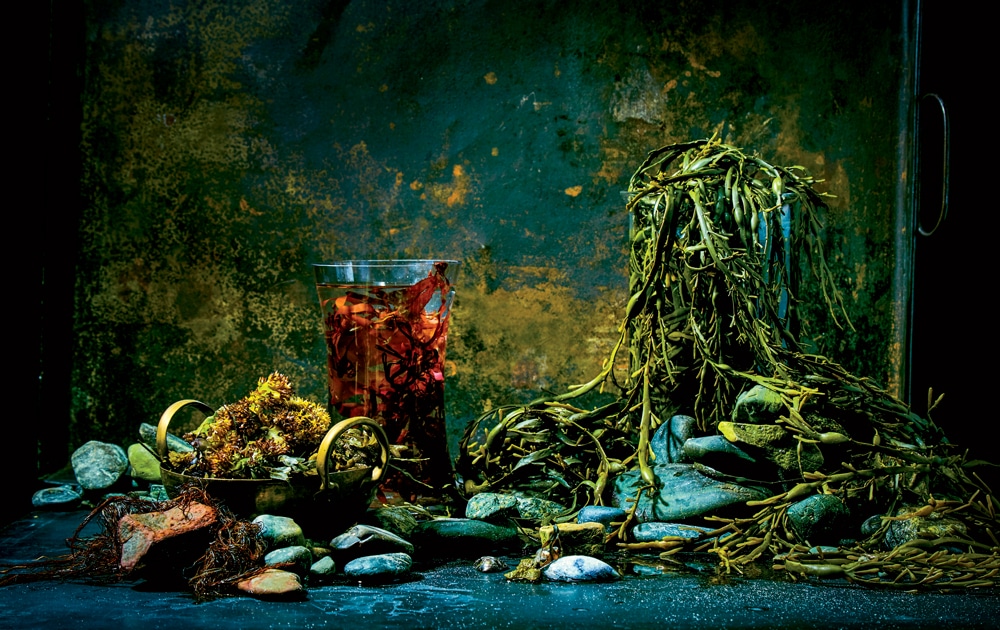
Harvesting wild seaweeds off the coast of Maine is an extraordinary lifestyle.
Photo Credit : Adrienne Anderson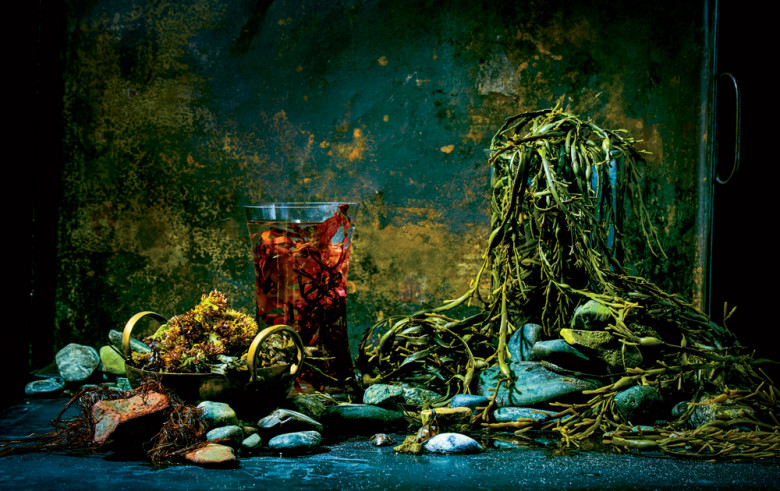
Photo Credit : Adrienne Anderson
On a gray dawn in October, a half mile off a small Maine island far from shore, Micah Woodcock and I found ourselves bobbing in a rowboat precisely where they tell you not to go in boats.
That, in fact, was how Micah had described his foraging strategy to me: “Look at a chart, look for trouble, go there.” All around us, the teeth of ledges rose in and out of the water with the swell. The water was the color of slate. The sky was spitting a 50-degree rain into a 50-degree sea. Micah expertly sidled the rowboat up to a ridge that breached the sea for a few hundred yards and said, “Get out.”
I stared at him in disbelief, teeth chattering. Here? Now?
“Get out fast,” he said. “I can’t get any closer.”
And so I and my wet suit flipped ourselves out of the boat and into the churning, neck-deep water. Micah tossed me an inner tube with a laundry basket jammed into the middle and handed me a fillet knife. “You should find lots of kelp along this ridge,” he told me. “Try to cut it cleanly. I’m going to work a little farther out.” As he rowed away, he glanced back at me. “Don’t drop the knife.”
Right. Iron grip on the knife, I scooched along the underwater shelf, the inner tube tethered to my wrist by a rope, hopping with each wave to keep from going under. Long, leathery things wrapped themselves around my ankles. They felt like eels, but I hoped they were kelp. Timing the trough between waves, I leaned down and grabbed one. Yep, kelp. I slashed at it with my knife, narrowly missing my leg, and tossed the slippery fettuccine into my basket. Then a wave picked up the basket and tossed it into my face. Don’t drop the knife.
I spotted Micah, who is very tall, very thin, and very 27, way out on a submerged ledge, wearing snorkel gear and cutting kelp. He has the beard and wide eyes of a Byzantine saint, and he seemed to be walking on water. He brought up lovely, wide, 6-foot strands and quickly filled his basket. I, meanwhile, was fighting to wrestle my 4-foot kelp into the basket without spilling the basket, losing the knife, or getting smashed into the rocks. I was working so hard to stay on my feet that I barely noticed the rain and the icy sea. The boulders behind me were draped in slippery brown seaweed and glowing pink lichen, the waves burst with white foam, and the spruce trees on Micah’s distant island were backlit by the dawn, and it occurred to me that of all the ways I’d ever imagined to make a living, this might be the hardest and the most beautiful. And I began to understand Micah Woodcock.
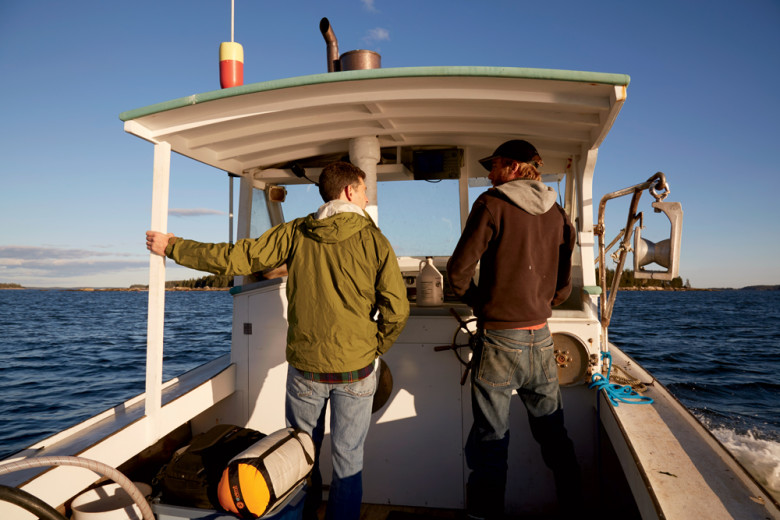
Photo Credit : Adrienne Anderson
Micah is one of Maine’s handful of harvesters of wild seaweeds—or sea greens, as I’d taken to calling them, to differentiate from the piles of sea compost I’d always avoided on the beach. It’s an extraordinary lifestyle. During the eight-month harvest season (even Micah won’t go out in winter), he lives in a simple cabin on a tiny island off Maine’s midcoast. It’s one of the ledgiest sections of shoreline, which is doom for boats but heaven for seaweed, which needs to attach to rock near the surface, where the light is. Most days, he visits the surrounding ledges and islets at low tide, fills his boat with seaweed, returns to the island, and hangs his harvest on clotheslines to dry (wet seaweed quickly spoils). There, blowing in the wind like a load of dark stockings, it loses all its slime and 90 percent of its weight in a few hours and becomes as stiff as shoe leather. Once a week, he packages it, hauls it to the mainland in his lobster boat, and delivers it to customers by hand or by mail. “It’s an unbelievable amount of work,” he admitted. “I had no idea what I was getting into.”
While there are no slackers in the seaweed guild, some harvesters prefer the species that can be picked on land at low tide. But Micah likes to live his life in the crashing interface of land and sea. “A lot of edible seaweeds only grow in places that are turbulent,” he said. “If sugar kelp is growing in a harbor or another place without much flow, you get much wider, weaker plants. But in a place like a reversing falls, where there’s a lot more current, you get stronger, longer, skinnier plants. I like them better. They’re more vital.” Digitata and alaria, two kelp species, grow at the lowest point of the low-tide line on ledges; to harvest them, Micah sometimes has to ride big breakers over the ledges to get his boat into the more protected spots.
Why do such a thing? I wondered that more than once as the waves swept me and my basket off the ledge. I wondered it some more as we filled Micah’s rowboat with hundreds of pounds of kelp and alaria and returned to the island in the rain. I wondered it again as we hauled baskets of seaweed from the landing up to a little barn and hung it inside to dry. And I was still wondering as we peeled off our wet suits and stoked the fire in the cabin and set the coffeepot to perk and my shivers slowly subsided, until I realized I was having a really good time. What could be better than a morning of hard work in a world primeval? Micah agreed: “I love how ancient these species are. How resilient they are. How they grow in places where nothing else can survive. It’s such a beautiful, rarely seen world.”
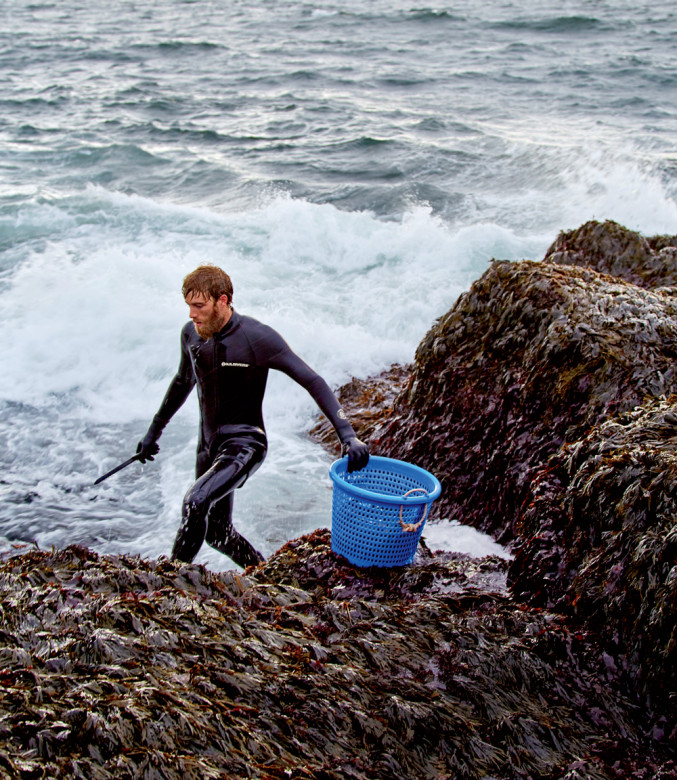
Photo Credit : Adrienne Anderson
—
At the moment, the modern world’s attention is fully on sea greens. Kelp is the new kale. Dulse is the new bacon. Which makes Maine the new California, because the great sea greens flourish on the Atlantic coast north of Cape Cod. “All the commercial seaweeds are cold water–loving seaweeds,” Shep Erhart, founder of the country’s largest sea greens company, Maine Coast Sea Vegetables, told me. “We’ve got a lock on it.” Indeed, as we toured his brand-new plant in Hancock, about 20 miles northeast of Micah’s island, we were in the Fort Knox of American seaweed. Women with band saws were cutting 10-foot-long pieces of dried kelp into bag-sized strips as a fine salt mist filled the air. Pallets of applewood-smoked dulse and Kelp Krunch energy bars sat on loading docks. There were bags, capsules, and shakers of nori, alaria, dulse, Irish moss, bladderwrack, and sea lettuce, all from the Gulf of Maine and the Bay of Fundy. Shep kept letting me smell things, coaching me through the differences. “Nori’s mild but nutty. Digitata tastes the sweetest. Alaria has an almost Soave quality to it.”
The plant was so new you could smell the paint. You could also smell the skunky funk of dried seaweed infiltrating every corner. For decades, Shep ran everything out of an ever-expanding “rabbit warren” of lofts, barns, and temporary buildings. Now a balding and bushy-browed gnome nearing retirement and slowly handing over the reins to his daughter Seraphina, he finally has his dream facility.
With 20 full-time employees, Maine Coast Sea Vegetables is the primary buyer of American sea greens. In 1971 Shep and his wife, Linnette, began harvesting alaria, which they’d realized was a local version of the expensive Japanese wakamethey were buying for their macrobiotic cooking, and started selling it to their friends, then to a few stores, then to national distributors. Pretty quickly they learned it made far more sense to process and distribute the stuff than to plunge into the waves after it, and today they buy from 50 wild harvesters and process 100,000 pounds of seaweed each year. Now that seaweed has broken out of the hippie aisle and gone mainstream, they hope to sell a lot more than that. Seaweed’s rising popularity stems in part from its new “superfood” status—it is astoundingly rich in vitamins, minerals, fiber, and omega-3s—and in part from its having gourmet cachet in a culture obsessed with exotic, wild, and regional ingredients.
If there’s an “it” seaweed, it’s dulse. “It’s getting very, very popular,” Shep said, popping open a bag so that the rich applewood smoke smell filled the room. “You can eat it right out of the bag.” We did. It resembled wrinkled red cabbage leaves and chewed like salty salmon skin—definitely not bacon—but after a few seconds it dissolved like taffy, leaving me craving another mouthwatering hit. “It’s a great snack. It’s not for sissies, but once you get into it, you get hooked.”
Most of the world’s dulse comes from Grand Manan Island, a 21-mile-long island in the Bay of Fundy seemingly designed for dulse. Its 300-foot cliffs shade the intertidal plant, which can bleach and toughen in the sun, and the Bay of Fundy’s famed 30-foot tides create a vast amount of intertidal real estate where it can grow. Locals on Grand Manan eat dulse like popcorn. For decades it’s been sold in small paper bags on the ferry, in gas stations, at roadside stands, and even as bar snacks.
Now that the rest of us have discovered dulse (or “Columbused” it, as Micah puts it), not even Grand Manan can produce enough to keep up with demand. “Supply is a big issue right now,” Shep admitted. “We’re not going to get enough dulse for the fourth year in a row. And I’m going to have a hard time getting enough kelp this year.” Even in Maine, there are only so many places with the right combination of rock, current, and accessibility, and everyone involved is worried about overharvesting seaweeds that serve as prime habitat for many other species.
“Sustainability is a key issue,” said Shep. “This is one of the few fisheries that still has a chance at sustainability. All the other ones have pretty much shot themselves in the foot.”
Up to now, the grassroots nature of the seaweed industry in Maine has kept it in check, according to Micah: “With seaweed, the harvesters have a big stake in the long-term sustainability of it. It’s all very obvious. We all know who’s harvesting where, and we give each other area to work. It’s culture and tradition, like with lobstering. And that’s a huge part of sustainability. You need to have strong communities and people who are invested in the long-term health of the places where they live.”
Yet no amount of rules or community self-monitoring can solve the new imbalance between supply and demand. If Maine sea greens are to feed the nutrient-starved children of America, we need a lot more than the wild can provide. That’s why virtually all fingers in the industry point toward aquaculture as the future of sea greens. And in Maine, if you follow those fingers, they lead to Sarah Redmond.
—
On a January morning that made my fall dip with Micah feel like a day at Club Med, I hopped into a skiff with Sarah and sped out to a square of sea in Frenchman Bay marked by four orange buoys. Nothing else was moving on the bay. We were just a few miles up U.S. 1 from Maine Coast Sea Vegetables, which was not entirely coincidental: Shep was once Sarah’s partner in this farm. The snowy bulk of Cadillac Mountain loomed above Bar Harbor and the breeze froze our cheeks until we could barely speak, but it felt clean and bracing on the water. I could see lines running between the buoys about 5 feet beneath the surface. Sarah hooked one and pulled it up. A curtain of footlong baby kelp plants hung from it, dripping diamonds in the winter light.
“Aren’t they beautiful!” said Sarah, who when I met her was the seaweed aquaculture extension agent for the University of Maine; today she’s a full-time seaweed farmer. A brown-eyed bundle of seaweed fervor, Sarah could make a sea greens fan out of a polar bear, but she was right: They were beautiful. And they were beautiful because they were supple, and shiny, and alive. The winter landscape was barren, but this kelp was burgeoning. Sarah had planted it in the fall, and it was just getting started. As the daylight increased in February and March, it would take off, growing several centimeters a day. By the time it was harvested in spring, each strand would be about 10 to 15 feet long and weigh about 10 pounds per foot. Unburdened by gravity or root systems, seaweed grows at a rate no terrestrial crop can touch, even in winter, and that has a lot of people very, very excited about farming it.
To say that seaweed aquaculture is the greenest form of farming on earth does not do it justice. It is so much greener than anything else that it needs to have some new color invented for it. It makes something from nothing, pulling excess carbon, nitrogen, and phosphorus from the water and assembling it into nutrient-rich organic vegetables. That gives it a negative carbon footprint. More seaweed, healthier planet. A seaweed farm can produce twice the protein per acre of a soybean farm and 17 times that of a livestock farm. And it does it all without any inputs of energy, fertilizer, or water.
Many experts believe seaweed farms could feed the world using a fraction of the resources used by agriculture. The industry in the U.S. is growing, but it lags far behind that of other countries. Most of the seaweed consumed here comes from Asia, where seaweed aquaculture is a $5 billion industry.
At UMaine, it had been Sarah’s job to change that. “Stuff is happening so fast it’s hard to keep track,” she said. “There are farms up and down the coast. Tons of people are excited about doing this in Maine.” Surprisingly, she’d been deluged with requests from fishermen who had either given up on cod or were looking to do something in the off-season. “Fishermen already have boats, they already have knowledge of the water, and they’re into it.”
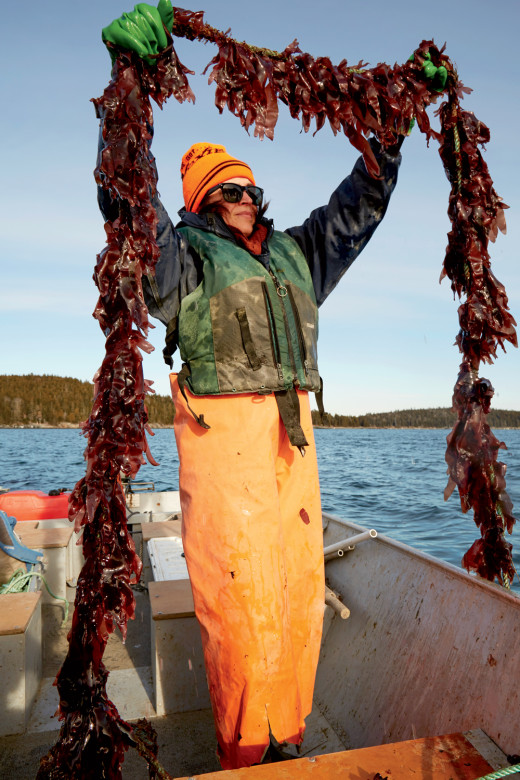
Photo Credit : Adrienne Anderson
What they don’t have, yet, is a system. No one is waiting on shore to buy, dry, or distribute the seaweed they grow. Shep is looking into it, but for now his customers are attached to the robust flavors and perceived mojo of wild product. And even if the system were in place to get it to market, farmed Maine seaweed would still have to compete with cheap Asian seaweed.
Sarah was quick to point out the mismatch: “We have some of the best seaweed in the world! Asian seaweed can’t compete with ours. There’s a huge flavor difference. I didn’t like seaweed at first, because my only experience was with Asian seaweed, which tastes fishy. Ours always tastes fresh and clean.”
The difference, Sarah said, is that a lot of Asian seaweed is being grown in some grim industrial waters. But the market has not learned to differentiate.
Perhaps Maine seaweed needs a makeover, I suggested. And then I proposed the term “sea greens,” which was exactly the wrong thing to say to Sarah Redmond, seaweed evangelist. “I’m not on board with that,” she said as she glared at me and chewed on fresh kelp, her nose and cheeks frosty pink. “It’s seaweed! Be proud of it! It’s amazing!”
Sarah might be the only person in the country who grew up wanting to be a seaweed farmer. “I’m a plant person,” she shrugged. “I like growing things. I spent a lot of time at the shore as a kid. Seaweed attracted me.” She enrolled as a graduate student under Charles Yarish, the University of Connecticut professor who is America’s leading expert on seaweed aquaculture. At UConn, she designed the seaweed seeding system used by the entire New England industry. Its simplicity is hugely appealing: When a kelp plant is ready to produce spores, in summer, you put it in a tank of water with some thin line. The spores attach to that line; when they’ve matured into juvenile plants, you wind this “seed” line around a rope and suspend it from the ocean surface. The plants do the rest.
Sarah graduated from UConn in 2012 and was immediately hired by the University of Maine to develop seaweed aquaculture in the state. In her labs at UMaine’s Center for Cooperative Aquaculture Research on Taunton Bay, she produced spools of seed line and gave them away to new kelp farmers.
Sarah dropped the kelp line back into the water and we moved on to a line draped in alaria, the fernlike cousin to wakame. We nibbled on it as I stuffed a mesh bag to take home, freezing my hand in the process. It was tender, slender, and spunky, the Audrey Hepburn of salad greens. It had an addictive crackle and a lively green-tea flavor.
If these were the wimpy plants Micah disdained, well, I guess that made me a wimp too. I realized that in my seaweed travels I had accidentally recapitulated the Fall of Man, from Micah’s prelapsarian wild forests to Sarah’s convenient kelp plots. And as profound as dreamtime with Micah had been, it was Sarah who would be feeding The Future.
If The Future was willing to eat it. Of that I still wasn’t sure.
—
Two days later, The Future came stomping into our mudroom after school, ravenous, and regarded the bowl of seaweed I set before him with suspicion. The Future is 17, his name is Eric, and after school he’s in no mood to be trifled with until copious carbohydrates have been consumed.
“Dulse,” I said, before he could ask. Then I gave him the spiel about the Grand Manan islanders and popcorn.
He flicked a piece into his mouth, chewed, swallowed. “Good,” he said. Then he polished off the bowl.
OK, I’d figured dulse might be easy. The real test would be dinner, a full-on seaweed smorgasbord. When I consulted my new seafriends about recipes, I heard a lot of the same suggestions.
“Kelp is really good in heavy, hearty, pot-roasty dishes,” Micah said. “I cut it up dry with scissors and add the pieces to any savory liquid dish and cook it for 30 minutes or five hours. You want to have either nice tender pieces, or you want it to dissolve. In the middle you get sea-monster gooeyness.”
“We love seaweed!” said Andrew Taylor, the chef at Portland’s wildly popular Eventide Oyster Co. “Kelp makes its way into almost all of our stocks, soups, and sauces. It provides a wonderful depth of flavor to everything you put it in.”
A flavoring, in other words, which is the same thing Shep told me. “It’s just a no-brainer. Anything you’re cooking in water, you put some kelp in that broth. It has that umami taste, plus all this rich mineral content, plus polysaccharides that give a little body to your soup.”
Honestly, if every hockey mom in America started making her soup broth out of Maine seaweed, it would use everything the farms can grow and we could all declare victory. But I wanted seaweed to be more than the bouillon cube of the 21st century. I wanted it to be … food.
So I fried some nori in oil until wicked crisp. If dried dulse was the popcorn of the future, this was clearly the potato chip.
I tossed the alaria in sesame oil and rice vinegar and made a superb, if not terribly creative, seaweed salad.
I concocted a soba noodle soup flecked with bright green bits of alaria and enriched with a kelp broth. Who would object to such a thing? Certainly not The Future, who cleaned two bowls.
And for my pièce de résistance, I boiled a tangle of kelp noodles, drenched them in olive oil and garlic … and quickly threw them out. I felt like Captain Nemo battling the giant squid. A lot of people would like kelp to be the new linguine, but for now it just isn’t.
Still, I thought my success rate was pretty high, and I felt confident that seaweed was more than a trend. I asked Eric how he felt about it.
He shrugged. “Just like any other … land weed.”
“Shouldn’t we call it sea greens?” I tried, ever hopeful.
He grimaced as though I’d asked him if he wanted to go to a James Taylor concert with me. “It shouldn’t have to masquerade as spinach.”
Right. “So, to you, it’s just food.”
“Yup.”
“And it’s good?”
“Yup.”
“Would you say really good?”
Another shrug. “Good enough.” And then The Future grabbed the bag of dulse and went up to his room to check his Tumblr feed.


